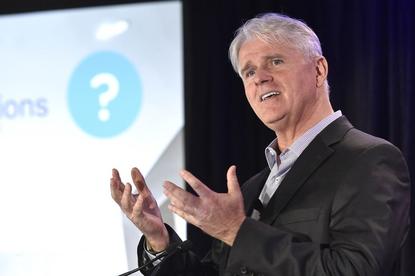NBN reaches halfway mark
- 10 July, 2017 06:00

NBN CEO Bill Morrow
Construction of the National Broadband Network has reached the halfway point, with NBN indicating it believes it is on track to meet its 2020 goal of completing the rollout.
More than 5.7 million premises are able to connect to the NBN. Around 100,000 premises are being hooked up to the network every week, the government-owned company said today.
NBN in May released figures revealing that around 2.2 million households had actually signed up for services on the network; however, it said that on average an additional 130,000 end users were signing up every month.
“I’m proud to announce that one in two Australians are now able to enjoy the benefits of fast broadband by connecting to the NBN network through a retailer,” NBN CEO Bill Morrow said in a statement released today by the company.
“Nationwide access to fast broadband will become the platform to launch Australia into the next phase of its digital future – it will change what our jobs will look like, where we will live and how we fare on a global scale.”
NBN earlier this month restructured its operations as the halfway point approached, with the company saying it was part of a shift in emphasis from “network build” to “network operate and optimise”.
The company last month began rolling out fibre to the curb (FTTC), which is newest member of the company’s “multi-technology mix”.
“The rollout of the NBN network is one of the most complex and ambitious initiatives to be undertaken in any market across the world,” Morrow said.
“We’re building a nationwide network that has the ability to deliver wholesale speeds which are currently around eight times faster than the average capacity available on the majority of Australia’s existing broadband services.
“Our team is on budget and ahead of schedule to connect millions of Australian homes and businesses in the next few years and ask for your patience as we make the transition from the old to the new network.”
Shadow communications minister Michelle Rowland said the milestone was no cause for celebration, however.
“Malcolm Turnbull promised every Australian would have access to the NBN by the end of 2016, yet as of today over 5.5 million homes and small businesses are still waiting,” Rowland said.
“Malcolm Turnbull promised an NBN that was faster and more affordable. Instead he has pushed ahead with a slower, less reliable and more expensive copper-based NBN nightmare. He dug his heels in on copper and that has come back to haunt him.”
The experience of end users on the NBN “has been nothing short of abysmal,” Rowland said.
“People across the community are fed up with ongoing slow speeds, dropouts, buck passing and the inability to have their NBN problems resolved.”
Earlier this year the Telecommunications Industry Ombudsman revealed NBN complaints to it had soared, although their growth was still trailing the pace of the rollout.
The Australian Competition and Consumer Commission (ACCC) is in the process of implementing a broadband performance monitoring scheme that will focus on the NBN.
The ACCC has said that the program will help assess whether performance problems encountered by end users are the fault of NBN or of retail service providers (RSPs) selling services on its network.
NBN has previously indicated it believed some speed complaints by consumers related to under-provisioning of network capacity by RSPs.
However, some consumers have also been sold broadband plans with theoretical speeds that exceed what their households’ connections are capable of — Telstra, for example, recently revealed broadband plans with maximum speeds that were not achievable.
